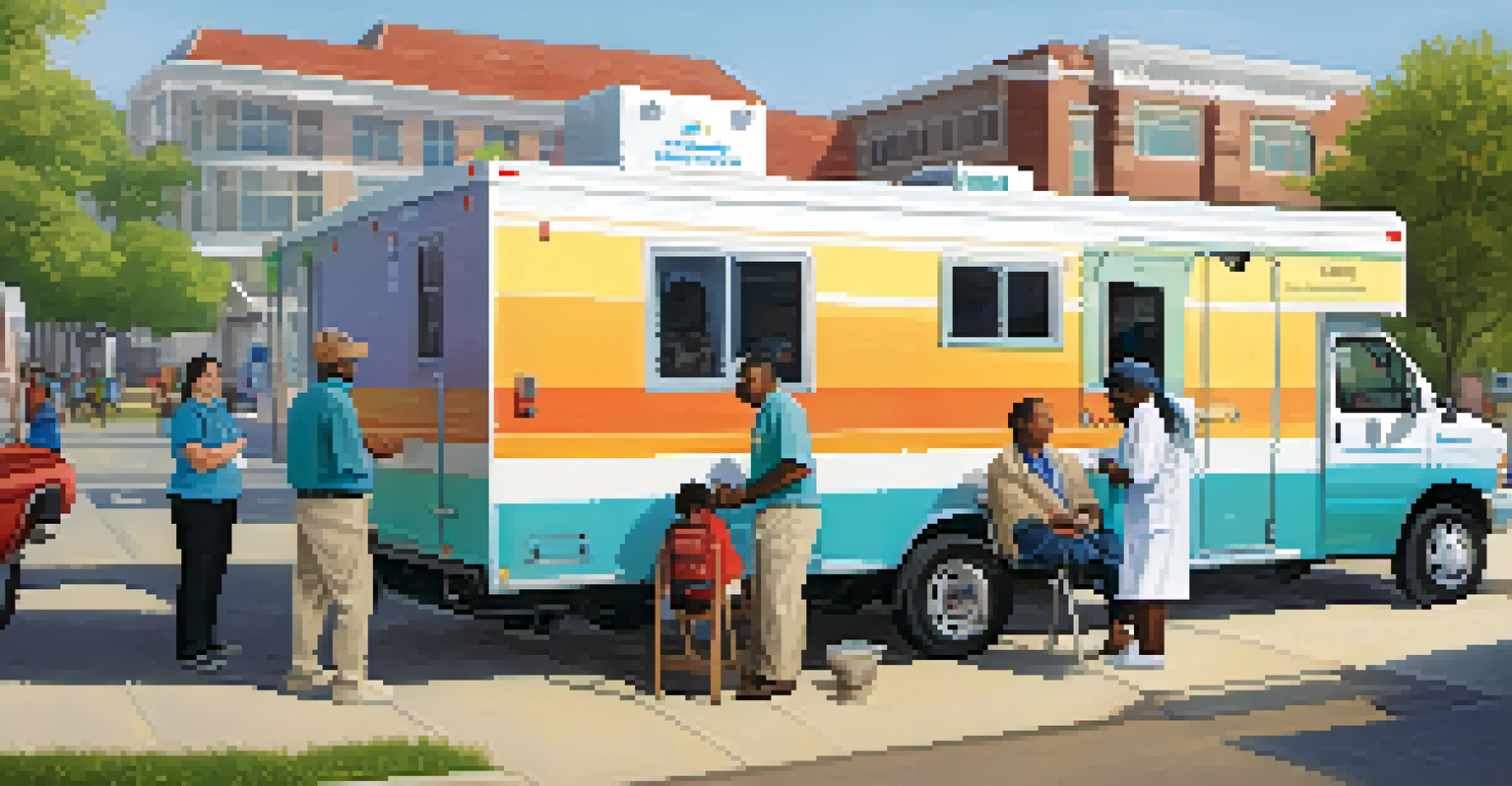Innovative Approaches to Preventative Care in California Clinics

Telehealth: Bridging Gaps in Preventative Care Access
Telehealth has revolutionized how patients access preventative care, especially in rural areas of California. With virtual appointments, individuals can consult healthcare providers from the comfort of their homes, breaking down geographical barriers. This approach has increased participation in routine screenings and health education, ensuring that more patients receive timely interventions.
The greatest medicine of all is to teach people how not to need it.
Moreover, telehealth allows for continuous monitoring of chronic conditions, which is essential for preventative care. Patients can send health data directly to their providers, enabling proactive management of their health. This shift not only enhances patient engagement but also helps clinics optimize their resources effectively.
As telehealth continues to evolve, California clinics are finding innovative ways to integrate it into their services. By combining virtual solutions with in-person care, they create a holistic approach to health that prioritizes prevention and accessibility.
Community Health Initiatives: Partnering for Better Outcomes
California clinics are increasingly collaborating with community organizations to enhance preventative care. These partnerships focus on education, outreach, and resources tailored to specific populations. For instance, workshops on nutrition and exercise can empower communities to make healthier choices, reducing the risk of chronic diseases.

Such initiatives also leverage local knowledge and relationships, making health education more relatable and effective. When community members are involved in planning and executing these programs, the outcomes often reflect their needs and preferences. This tailored approach fosters trust and encourages individuals to take charge of their health.
Telehealth Enhances Access to Care
Telehealth breaks geographical barriers, allowing patients, especially in rural areas, to access preventative care services conveniently from home.
By working together, clinics and community organizations can create a supportive network that promotes preventative care. This synergy not only improves health outcomes but also strengthens community ties and builds a culture of wellness.
Mobile Clinics: Taking Care to the Community
Mobile clinics have emerged as a dynamic solution to deliver preventative care directly to underserved populations in California. These clinics travel to various locations, offering services like vaccinations, health screenings, and educational workshops right where people live and work. This convenience helps eliminate barriers such as transportation and time constraints.
An ounce of prevention is worth a pound of cure.
The flexibility of mobile clinics allows them to respond quickly to community needs, adapting their services based on local health trends. For example, during flu season, they can focus on immunizations, while other times they might emphasize chronic disease screenings. This adaptability ensures that the services provided are relevant and timely.
Additionally, mobile clinics often collaborate with local health departments and organizations to maximize their impact. By pooling resources and expertise, they can reach a broader audience and provide comprehensive care that prioritizes prevention.
Data-Driven Decision Making for Customized Care
California clinics are harnessing the power of data analytics to enhance their preventative care strategies. By analyzing patient data, clinics can identify trends and risk factors specific to their populations. This information helps healthcare providers tailor their services and outreach efforts to address the unique needs of their communities.
For example, if data reveals a high incidence of diabetes in a particular area, clinics can implement targeted education programs and screenings. This proactive approach not only improves individual health outcomes but also contributes to overall community wellness. Patients are more likely to engage with services that directly address their health concerns.
Community Partnerships Improve Outcomes
Collaborations between clinics and community organizations foster tailored health education and resources that empower individuals to make healthier choices.
Moreover, data-driven insights enable clinics to measure the effectiveness of their preventative care initiatives. By tracking outcomes and patient feedback, they can continuously refine their programs, ensuring they remain relevant and impactful.
Integrative Medicine: A Holistic Approach to Prevention
Integrative medicine is gaining traction in California clinics as a holistic approach to preventative care. This model combines traditional medical practices with complementary therapies, such as acupuncture, nutrition counseling, and mindfulness techniques. By addressing the physical, emotional, and social aspects of health, integrative medicine promotes overall well-being.
Patients often find that this comprehensive approach helps them feel more empowered in managing their health. For instance, a patient dealing with stress-related health issues may benefit from both conventional treatment and stress-reduction practices like yoga or guided meditation. This dual focus can lead to better health outcomes and improved quality of life.
As integrative medicine continues to grow, clinics are exploring ways to incorporate these therapies into their preventative care offerings. This trend reflects a broader shift towards personalized healthcare that recognizes the interconnectedness of mind and body.
Health Education: Empowering Patients for Preventative Care
Health education plays a crucial role in preventative care, and California clinics are prioritizing this aspect more than ever. By providing patients with the knowledge and tools they need to make informed health decisions, clinics empower individuals to take charge of their well-being. Workshops, seminars, and informational resources are becoming staples in many healthcare settings.
For example, educating patients about the importance of regular screenings and healthy lifestyle choices can significantly impact their long-term health. When individuals understand their risk factors and the steps they can take to mitigate them, they are more likely to engage in preventative care. This proactive mindset is essential for reducing healthcare costs and improving population health.
Technology Transforms Preventative Care
The integration of technology, including wearable devices and health apps, enhances patient engagement and enables real-time health monitoring.
Furthermore, clinics are utilizing various platforms, including social media and online resources, to reach a broader audience. By making health education accessible and engaging, they can inspire even more people to prioritize their health.
Collaboration with Technology: Enhancing Preventative Care
The integration of technology in healthcare is transforming preventative care in California clinics. Wearable devices, health apps, and online platforms are empowering patients to monitor their health in real-time. For instance, fitness trackers can encourage individuals to stay active and maintain their health goals, while health apps can remind them about appointments and medication schedules.
Additionally, clinics are utilizing telemedicine platforms to facilitate follow-up appointments and health check-ins, making it easier for patients to stay engaged with their care. This technology-driven approach not only enhances patient experience but also allows healthcare providers to maintain regular contact and provide ongoing support.

As technology continues to advance, California clinics are exploring innovative ways to integrate these tools into their preventative care strategies. By embracing digital solutions, they can offer more personalized and efficient care that resonates with today's tech-savvy patients.